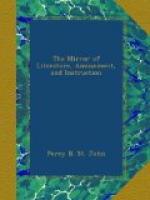“Should canopy his bones till doomsday;
But all things have their end.”
The ruins of this religious house are more entire and superb than any other in the kingdom. The nave of the church is wholly gone; but the choir, one of its aisles, great part of the tower, and both the transepts, still remain. The church, instead of being east and west, approaches more to the direction of north and south; so that the choir is at the south end, and the aisle which should have been north, is on the east. Some have supposed this anomaly to be produced at the rebuilding of the church; but Drake in his “Evenings in Autumn,” thinks it was in consequence of the disposition of the ground, which forms a lofty mount on the east. Adjoining the ruins of the nave on the west, are the remains of the cloisters, measuring one hundred feet each way. On the opposite side stands a splendid building, extending in length towards the west one hundred feet, and in breadth thirty; this structure appears to have been the refectory, accompanied by a music gallery. Parallel to this, and in a line with the transept, is another extensive ruin, several feet longer than the refectory, and about the same breadth, which was the dormitory; at the west end of which the walls are ancient, and seem to be coeval with the original abbey.[6] The form and ground plan of this building are the same with the abbey of Whitby; though the latter is not so copious in its dimensions. Several members of the noble families of Ross, Scroop, Maltbys, and Oryby, were interred in the chapter-house and choir here. Aelred, the third abbot of Rievaulx, was a man of great literary qualifications, and this abbey possessed an extensive library, which was destroyed by the Scots, in one of their lawless incursions—when the studious produce of the holy brotherhood, assembled by years of incessant study was committed to the reckless flames—and doubtless amongst the collection were many works of the learned abbot Aelred; a character from whom we might suppose the “northern magician” had sketched the striking portraiture of the enthusiastic father Eustace, in his “Monastery.”
After inspecting this interesting edifice, we left its hallowed precincts, and took the hilly path leading to a beautiful terrace, which overlooks the vale; each end of which is decorated with two modern temples, one in the Grecian and the other in the Roman style of architecture. Here are some gaudy copies of the old masters, with some originals, which adorn the centre and side compartments of the ceiling—Guido’s Aurora, (copy); Hero and Leander; Diana and Endymion; Hercules and Omphale, &c,—the whole by the pencil of Bernini, an Italian artist. From this terrace the view is enchanting; the distant hills of barren Hambleton subsiding into the fruitful vale; and nearer, fertile fields intersected with wood and mossy rocks; and immediately beneath the eye, the pale and ivied ruin, mouldering over the dust of heroes who fought at Cressy, and of noble pilgrims who died in the Holy Land, and were conveyed to this far-famed sanctuary for interment—




